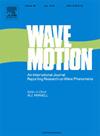(3+1)- 维非线性演化方程的黎曼-希尔伯特问题
IF 2.1
3区 物理与天体物理
Q2 ACOUSTICS
引用次数: 0
摘要
本文主要研究(3+1)维非线性演化方程。通过引入变换,(3+1)维非线性演化方程被分解为三个可积分的(1+1)维模型。在四元 Lax 对的基础上,我们建立了相关的矩阵黎曼-希尔伯特问题。因此,用与无反射相对应的同一跃迁矩阵求解得到的矩阵黎曼-希尔伯特问题,就得到了 (3+1)- 维非线性演化方程的孤子解。特别是,对一孤子解进行了计算和图形分析。本文章由计算机程序翻译,如有差异,请以英文原文为准。
Riemann–Hilbert problem for a (3+1)-dimensional nonlinear evolution equation
This paper concentrates on a (3+1)-dimensional nonlinear evolution equation. By introducing a transformation, the (3+1)-dimensional nonlinear evolution equation is decomposed into three integrable (1+1)-dimensional models. On the basis of a quartet Lax pair, we build the associated matrix Riemann–Hilbert problem. As a consequence, solving the obtained matrix Riemann–Hilbert problem with the identity jump matrix, corresponding to the reflectionless, the soliton solution to the (3+1)-dimensional nonlinear evolution equation is acquired. Specially, the one-soliton solutions are worked out and analyzed graphically.
求助全文
通过发布文献求助,成功后即可免费获取论文全文。
去求助
来源期刊

Wave Motion
物理-力学
CiteScore
4.10
自引率
8.30%
发文量
118
审稿时长
3 months
期刊介绍:
Wave Motion is devoted to the cross fertilization of ideas, and to stimulating interaction between workers in various research areas in which wave propagation phenomena play a dominant role. The description and analysis of wave propagation phenomena provides a unifying thread connecting diverse areas of engineering and the physical sciences such as acoustics, optics, geophysics, seismology, electromagnetic theory, solid and fluid mechanics.
The journal publishes papers on analytical, numerical and experimental methods. Papers that address fundamentally new topics in wave phenomena or develop wave propagation methods for solving direct and inverse problems are of interest to the journal.
 求助内容:
求助内容: 应助结果提醒方式:
应助结果提醒方式:


